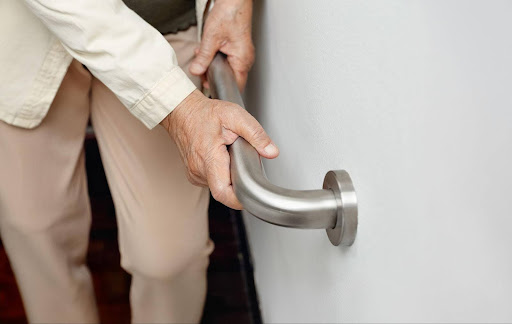Every year, thousands of Canadian seniors suffer preventable injuries inside their own homes – most often due to slips, trips, or burns in high-risk areas like bathrooms, kitchens, and stairways. As mobility, vision, and balance change with age, everyday spaces can quickly become senior hazards. Simple, proactive steps such as installing grab bars, removing loose rugs, improving lighting, and organizing cluttered walkways can dramatically reduce these risks. Prioritizing elderly fall prevention and applying practical senior safety tips are essential to supporting independence and long-term well-being at home.
Table of Contents
- Top Danger Zones in the Home Every Senior Should Avoid
- Practical Home Modifications That Make a Real Difference
- Final Thoughts: Prioritizing Prevention for Independent Living
For many older adults across Canada, home is more than just a place to live – it’s a source of comfort, identity, and autonomy. Yet as we age, familiar surroundings can quietly turn into danger zones. A wet bathroom floor, a dimly lit hallway, or a cluttered kitchen counter might seem minor, but they pose serious threats to senior home safety. In fact, falls are the leading cause of injury hospitalizations among Canadians aged 65 and older, and the majority happen right where seniors feel safest: at home.
Recognizing and addressing these risks early is key to maintaining independence and quality of life. That’s where thoughtful planning and support come in. Whether it’s reorganizing a bedroom for easier nighttime access or evaluating whether a loved one needs additional assistance with daily tasks, small changes can have a big impact. Many families find guidance through resources focused on elder care at home, which can help identify hidden risks and offer practical strategies tailored to individual needs.
With the right approach to home safety, seniors can continue living confidently in their own space – safely, comfortably, and with dignity.
Top Danger Zones in the Home Every Senior Should Avoid

Not all risks in the home are obvious, especially to those who’ve lived in the same space for decades. What once felt safe can become hazardous as physical abilities shift with age. Below are the five most common – and often overlooked – areas where senior hazards tend to cluster, along with specific risks and real-world examples.
Bathrooms: Slippery Surfaces and Poor Accessibility
The bathroom is consistently ranked as one of the most dangerous rooms for older adults. Wet tiles, lack of grab bars, and high-sided tubs create a perfect storm for slips and falls. Many seniors also struggle with standing up from low toilet seats or maneuvering in tight spaces. Even a minor fall here can lead to serious injury due to hard surfaces and sharp fixtures.
Key risks:
- Slippery floors without non-slip mats
- Absence of grab bars near the toilet or shower
- Poor lighting, especially at night
- Cluttered countertops with loose bottles or cords
Stairways: Missing Handrails and Inadequate Lighting
Stairs demand balance, strength, and clear vision – all of which can decline with age. A missing handrail on one side, uneven step heights, or dim lighting dramatically increases fall risk. Loose carpeting or worn treads are additional red flags often ignored until it’s too late.
Watch for:
- Inconsistent step depth or height
- Lack of handrails on both sides
- Shadows or glare that obscure visibility
- Items stored on stairs (e.g., laundry baskets, shoes)
Kitchens: Burn Risks and Cluttered Workspaces
While often associated with nourishment, kitchens pose multiple threats: hot stovetops, sharp knives, heavy pots, and slick spills. Seniors may forget a pot on the burner or struggle to lift a full kettle. Overcrowded counters also force awkward reaching or bending, increasing instability.
Common kitchen hazards include:
- Stove left unattended
- Slippery spills not cleaned immediately
- Heavy items stored overhead
- Poorly organized drawers causing rummaging
Hallways and Entryways: Tripping Hazards
These transitional spaces are frequently neglected in safety checks. Throw rugs, electrical cords, uneven thresholds, and low-clearance furniture can easily catch a foot or cane. Poor lighting near entry doors is especially risky when returning home in the evening.
Frequent culprits:
- Loose or curled-edge rugs
- Extension cords running across walkways
- Shoes or coats left on the floor
- Thresholds between rooms that aren’t level
Bedrooms: Poor Lighting and Unstable Furniture
Many seniors get up during the night to use the bathroom, often in near-darkness. Without motion-sensor nightlights or clear pathways, they risk tripping over beds, pet bowls, or discarded clothing. Additionally, wobbly dressers or chairs used for support can tip over under weight.
Bedroom-specific concerns:
- No nightlight or lamp within arm’s reach
- Cluttered floor space around the bed
- Unstable furniture used for balance
- Long cords from lamps or medical devices
To help visualize how these areas compare in risk level and mitigation effort, consider the following table:
| Area | Common Hazards | Ease Fix | Impact on Safety |
| Bathroom | Wet floors, no grab bars, poor lighting | Moderate | Very High |
| Stairways | Missing rails, uneven steps, low light | Moderate to High | High |
| Kitchen | Hot surfaces, spills, heavy overhead items | Low to Moderate | High |
| Hallways/Entry | Rugs, cords, clutter | Low | Moderate to High |
| Bedroom | Dark pathways, unstable furniture | Low | Moderate |
Practical Home Modifications That Make a Real Difference
Identifying hazards is only the first step. The real impact comes from making thoughtful, sustainable changes that align with how seniors actually live. The good news? Many effective modifications are low-cost, non-invasive, and don’t require major renovations. Below are actionable strategies grouped by priority and ease of implementation, designed to support both elderly fall prevention and overall senior home safety.
Lighting Upgrades for Clarity and Confidence
Poor lighting is a silent contributor to missteps and disorientation – especially at night. Instead of relying on a single overhead fixture, layer lighting throughout the home:
- Install motion-sensor nightlights in hallways, bathrooms, and bedrooms
- Use LED bulbs with a warm-white tone (2700K–3000K) for better contrast and reduced glare
- Place easily accessible lamps near seating areas and beds
Flooring and Pathway Adjustments
Smooth, unobstructed pathways are essential for walkers, canes, or even bare feet. Consider these adjustments:
- Remove throw rugs or secure them with double-sided tape or non-slip backing
- Replace loose carpeting or repair curled edges
- Keep cords and cables tucked against walls or run them through cord covers
Bathroom Safety Enhancements
This high-risk zone benefits most from targeted upgrades:
- Install grab bars near the toilet and inside the shower (not suction-cup types – they can fail under pressure)
- Use a non-slip mat or adhesive strips in the tub
- Raise the toilet seat or install a comfort-height model (17–19 inches)
- Add a shower chair or handheld showerhead for seated bathing
Kitchen Organization for Efficiency and Safety
A well-organized kitchen reduces strain and accident risk:
- Store frequently used items at waist-to-shoulder height
- Use automatic shut-off devices for stoves or electric kettles
- Keep a fire extinguisher within easy reach – not above the stove
- Wipe spills immediately and use non-slip mats under rugs
Smart Tech and Low-Tech Aids
Technology can offer peace of mind without compromising independence:
- Voice-activated assistants for calling help, setting reminders, or controlling lights
- Medical alert systems with fall detection (worn as pendants or watches)
- Reacher/grabber tools to avoid overreaching or bending
- Cordless phones or mobile devices placed in every major room
These modifications aren’t about turning a home into a clinic – they’re about creating an environment where senior safety tips translate into daily reality. Even small changes, like adding contrast strips to stair edges or labelling cabinet contents clearly, can boost confidence and reduce anxiety around movement.
When implemented thoughtfully, these adjustments support not just physical safety but emotional well-being – allowing seniors to move through their homes with greater ease, dignity, and control.
Final Thoughts: Prioritizing Prevention for Independent Living
Safety at home isn’t about fear – it’s about foresight. For seniors across Canada, the ability to live independently hinges not on grand overhauls, but on consistent attention to the small details that shape daily life. A well-placed grab bar, a clear hallway, or a nightlight that clicks on automatically may seem minor, but together, they form a foundation of confidence and control.
Elderly fall prevention isn’t a one-time checklist; it’s an ongoing practice that evolves with changing needs. What works at 70 might need adjustment at 80. Regularly walking through the home with fresh eyes – or asking a trusted friend or family member to do so – can reveal new risks before they lead to injury.
Equally important is fostering open conversations about safety. Many seniors hesitate to admit they’re struggling with stairs or reaching high shelves, fearing it might signal a loss of independence. But the opposite is true: addressing home safety seniors rely on actually preserves autonomy by preventing crises that could lead to hospitalization or relocation.



